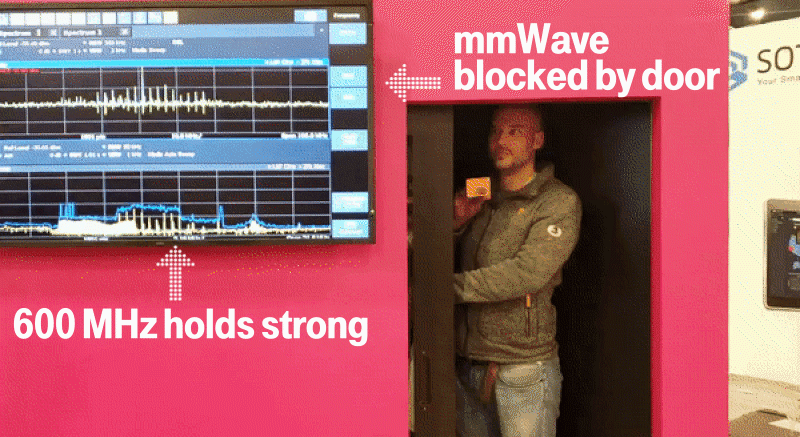Without the Right Spectrum, Is 5G All That?
Friday, April 26, 2019
Weekly Digest
Without the Right Spectrum, Is 5G All That?
You’re reading the Benton Foundation’s Weekly Digest, a recap of the biggest (or most overlooked) telecommunications stories of the week. The digest is delivered via e-mail each Friday.
Round-Up for the Week of April 22-26, 2019

Over the past few years, news of 5G – fifth generation wireless technologies – has grabbed too many headlines to count. As carriers start to rollout services in cities around the U.S., however, we’re now reading about some of the limitations of a service that policymakers have promised would improve lives.
A recent announcement by President Donald Trump commits the United States to build out 5G infrastructure on a high-band spectrum swath -- known as millimeter wave (mmWave), between 24 and 300 gigahertz -- which is “inferior in range and penetration capability to the ‘sub-6’ (below 6 gigahertz) spectrum being used for 5G by most other countries, especially China.”
There’s a difference between mmWave spectrum and low and mid-band spectrum. And that difference matters a lot for 5G and the future of wireless broadband in America. We saw so this week.
“If our leaders want the U.S. to be a 5G innovation zone, they can't be snowed by announcements of lots of short-range, millimeter-wave spectrum."
mmWave 5G: A Good Strategy?
Verizon wants mmWave spectrum to be a key component for both fixed-wireless and mobile 5G network rollouts in major urban areas. But analysts at MoffettNathanson have been questioning the economics of that strategy. Just a few weeks ago, the firm issued a research note arguing that Verizon’s use of mmWave spectrum for its 5G fixed-wireless service was making it difficult for the company to earn a profit on the service.
In Verizon’s very spotty, early fixed 5G deployments, MoffettNathanson noted, “even a 100-fold improvement in [its] current coverage and penetration wouldn’t be enough to make [its] existing architecture economically interesting.”
MoffettNathanson doubled down this week.
“There is a zero chance that 5G is a ubiquitous technology” by 2021, Craig Moffett said. “The standards of 5G were set for insanely wide blocks of spectrum,” he said. “You can’t find insanely wide blocks of spectrum anywhere but these stratospheric high frequencies.”
And a new research note from MoffettNathanson said that mmWave spectrum is “suited for a supporting, not a starring role.”

While the Lower 600MHz Signal is Unaffected
Verizon’s strategy was also criticized by T-Mobile’s Chief Technology Officer Neville Ray. He wrote, “MmWave spectrum has great potential in terms of speed and capacity, but it doesn’t travel far from the cell site and doesn’t penetrate materials at all. It will never materially scale beyond small pockets of 5G hotspots in dense urban environments.”
Reports this week on Verizon’s 5G offerings confirmed these problems.
Sascha Segan, reporting for PCMag, highlighted findings of PCMag’s tests of Verizon’s 5G offering in Chicago. “The millimeter-wave cell sites we saw got between 350-600 feet of range—enough for key downtown hotspots, to be sure, but without the range to cover entire cities or counties.” That's far short of what some wireless companies have quoted in the past. “Verizon has given me numbers between 800 feet and 3,000 feet depending on the circumstance,” Segan said.
Sean Hollister also reported on 5G in Chicago and found similar problems. “Proximity really matters here. If you can see one of these nodes, you’re probably within 5G range. But walk far enough away, and you’ll fall back to LTE. Building penetration is also a challenge for millimeter wave.”
Verizon CEO Hans Vestberg responded to the criticism, but sidestepped a direct question as to whether Verizon would abandon its effort to make mmWave spectrum a key component for its 5G rollout. He said mmWave spectrum “has lived up to our expectation on performance.” However, he did concede that “we will do it as far as it is economically sustainable.”
“We’re very early on in the journey,” Vestberg said. “I think that no one else in the whole industry knows more than Verizon about [millimeter wave] … From what we have seen on it, it’s a good strategy.”
Beyond mmWave Spectrum
In addition to the technical limitations of mmWave spectrum, MoffetNathanson raised the issue of the difficulty Verizon may face in obtaining low and mid-band spectrum licenses. Existing users, such as satellite companies and the U.S. Navy, are sitting on the spectrum.
Freeing up the right kind of spectrum for 5G is an ongoing challenge for the Federal Communications Commission, as Commissioners Michael O’Rielly and Jessica Rosenworcel have noted.
In a speech at the Brooklyn 5G Summit on April 25, Commissioner O’Rielly discussed the importance of mid-band spectrum for 5G. “Although high-band spectrum holds out great promise for 5G and future communications services...the U.S. government needs to be equally focused on providing the wireless sector with much needed mid-band spectrum for 5G networks.” He added, “While the facts clearly show the U.S. leading the world in allocating and auctioning millimeter waves, our actions in the mid bands haven’t been on par.”
Commissioner O’Rielly also said he was disappointed with the delay in the mid-band 3.5 GHz auction. The auction announced by Chairman Pai will occur in December 2019, pushing back the auction for mid-band spectrum until probably the second quarter of 2020.
Commissioner Rosenworcel said, “We are relying on high-band spectrum for which the network densification costs are exceptionally high and unlikely to be economically viable in vast swaths of this country. If we truly want to deploy 5G service to everyone, everywhere, we are going to have to pivot to mid-band, and the time to do it is now.”
“If our leaders want the U.S. to be a 5G innovation zone, they can't be snowed by announcements of lots of short-range, millimeter-wave spectrum. Our tests show that we'll need more mid-band spectrum to keep up with 5G demand across entire cities and counties,” wrote Segan. “The FCC should prioritize making that available as soon as possible.”
[For more on the mid-band spectrum options available to Verizon, see this telecompetitor article from Joan Engebretson]
5G and Rural Broadband
The test results from Chicago this week push back on the narrative that 5G is an answer for rural broadband.
Karl Bode wrote, “Wireless carriers have routinely pitched 5G as a compelling, lower-cost alternative to the fiber networks they’ve long failed to fully deliver. To hear giants like AT&T and Verizon tell it, 5G will easily push broadband to underserved rural markets, ultimately curing the digital divide at a fraction of the cost of full fiber deployment.”
“All available evidence suggests that relying on 5G to solve rural broadband challenges or creating real competition is misplaced,” said Christopher Mitchell of the Institute for Local Self Reliance. “It will help around the edges for a minority of households in both cases but will not substantially solve either problem for most.”
"Verizon's mmWave-only 5G plan is only for the few. And it will never reach rural America,” said T-Mobile’s Ray.
Conclusion
Deploying the next generation of wireless to all of America is a huge undertaking. For 5G to really be “all that,” we need comprehensive policy to make available the variety of spectrum bands needed -- and drive fiber network buildout farther and farther into rural America.
You can be sure we will be following along daily with all of the developments around 5G and rural broadband. You can stay up to date by subscribing to Headlines.
Quick Bits
- New York, Charter reach settlement (Albany Times Union)
- Sprint and AT&T settle lawsuit over ‘blatantly misleading’ 5G E logo (Vox)
- Announcement of opening date for Rural e-Connectivity Pilot Program application windows (Rural Utilities Service)
- NSA Recommends Dropping Phone-Surveillance Program (Wall Street Journal)
Weekend Reads (resist tl;dr)
- Millions of refugees need broadband, too (Washington Post)
- Why it's so hard for some Americans to get high-speed internet (Yahoo)
- Lifeline Delegation Discusses Concerns with Lifeline Proceeding (Free Press)
- Civil Rights Violations in the Face of Technological Change (Aspen Institute)
ICYMI from Benton
- Protect Privacy in Maine, Gigi Sohn
- Can “Slapping ‘New and Improved’ on CAF” Close the Digital Divide?, Robbie McBeath
Upcoming Events
April 30 -- Legislating to Stop the Onslaught of Annoying Robocalls, House Communications Subcommittee
April 30-- Strengthening the Cybersecurity of the Internet of Things, Senate Security Subcommittee
May 1 -- Consumer Perspectives: Policy Principles for a Federal Data Privacy Framework, Senate Commerce Committee
May 9 -- May 2019 Open FCC Meeting
May 14-15: National Summit on Digital Equity & Economic Inclusion, National Collaborative for Digital Equity
May 15 -- Research on the Economic Benefits of EBS, SHLB Coalition
May 22-24: Partnership for Progress on the Digital Divide 2019 International Conference
May 31 -- Deadline for Submission: Charles Benton Early Career Scholar Award
Benton, a non-profit, operating foundation, believes that communication policy - rooted in the values of access, equity, and diversity - has the power to deliver new opportunities and strengthen communities to bridge our divides. Our goal is to bring open, affordable, high-capacity broadband to all people in the U.S. to ensure a thriving democracy.
© Benton Foundation 2019. Redistribution of this email publication - both internally and externally - is encouraged if it includes this copyright statement.
For subscribe/unsubscribe info, please email headlinesATbentonDOTorg






